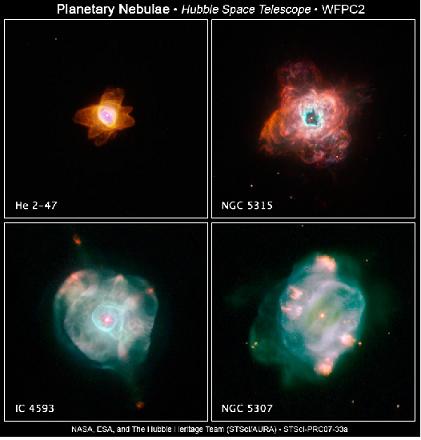Planetary nebulae are the remnants left when stars end their lives and shed their outer layer into space.

Planetary nebulae are some of the most beautiful objects in the universe. But don't let the name confuse you, they have nothing and nothing to do with planets. They are the remnants left when stars end their lives and shed their outer layer into space. In the image, taken by the Hubble Space Telescope, there are four such nebulae.
Although stars like the Sun reach the end of their long lives, they shed their outer layer in a series of dramatic events. The ultraviolet light from the star illuminates the material, causing it to glow as seen in the images taken by Hubble. The same ultraviolet light also disperses the cloud of matter, pushing it outward so that it eventually evaporates into the void of space.
Even though the star lives for maybe 10 billion years, the planetary nebula only exists for a moment - about 10,000 years.
On the upper left side of the picture, the He 2-47 nebula, nicknamed "Starfish" because of its shape. It has six distinct lobes, with each ejection event, the star ejects two streams of material.
On the upper right, the planetary nebula NGC 5315, which looks like the letter X. As in the previous case, it suffered from two events of ejections of material from the upper layers of the star's atmosphere, which blew out these layers and shot out jets in opposite directions.
IC 4593 in the lower left, which is in the northern Hercules group. Its spectacular shape is caused by the collision of the wind ejected from the central star during its transformation into a red giant and then a white dwarf, in a shed envelope. The completely spherical shape of the planetary nebula is a rare shape and is probably due to a certain type of angular momentum that the star receives and with which it continues to rotate.
And finally NGC 53O7, is on the lower right, it has a nice spiral shape. The dying star apparently experienced a series of pulsations as it ejected the gas, creating the complex shape seen in the image.

4 תגובות
It will happen to us too (that is, to our sun), but only in another 5 billion years. There is enough time to prepare.
Female that won't happen to us
The colors are fake colors.
They can indicate a variety of things and usually indicate the type of radiation emitted.
Beautiful and spectacular pictures, just correct me if I'm wrong, but it seems to me that the colors are not real and are only meant to symbolize the type of material or radiation it emits?